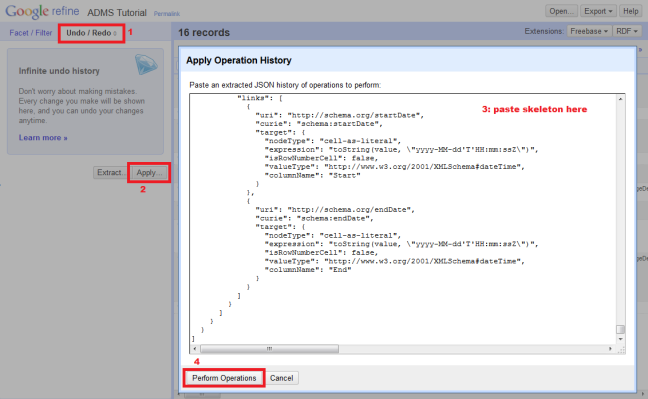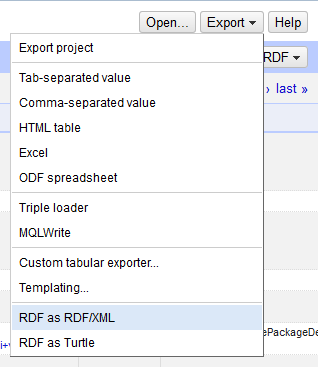The Application Profile of the Asset Description Metadata Schema (ADMS-AP) aims to extend the use of ADMS for the description of other types of interoperability solutions, meaning solutions covering the political, legal, organisational and technical interoperability layers defined by the European Interoperability Framework. This article shows how you can generate ADMS-AP descriptions of your interoperability solution from a spreadsheet using the RDF extension to OpenRefine released by DERI‘s Fadi Maali and Richard Cyganiak.
ADMS-AP helps you document the features of your interoperability solution such as its name, description, theme, asset type, representation technique, origin, publisher in a machine-readable way, which can be either ADMS XML or ADMS RDF format. Such machine-readable metadata in ADMS format brings the following benefits:
- De-centralised publishing: ADMS-AP allows you to describe your interoperability solution once and use this description everywhere.
- Federation of repositories: ADMS-AP allows interoperability platforms, such as Joinup, to aggregate description metadata from standardisation organisations, national semantic asset repositories, etc. The promo video of the ADMS-enabled federation nicely visualises this.
- Cross-repository querying: ADMS-AP is a common description format of interoperability solutions and will allow searching for assets located on disparate repositories.
- Faceted search: ADMS-AP is a rich metadata vocabulary which allows new user-interface techniques such as faceted search.
ADMS-AP published versions
On April 18, ADMS-AP v1.00 was released on Joinup (see announcement by WG Chair), under the ISA Open Metadata Licence v1.1. ADMS is an initiative of the ISA Programme of the European Commission [3] which formed a multidisciplinary working group of researchers, EU institutions, standardisation bodies and other experts.
It is important to take into account that the ADMS-AP Importer on Joinup only supports version 1.00 of ADM-AP. Therefore, federated solutions need to be compliant with ADMS-AP v1.00 specifications.
Based on experience gained and change requests received from different stakeholders, version 1.00 of ADMS-AP went through a revision process from December 2015 to April 2016. ADMS-AP v2 specifications were published as result of the revision process.
Generation of asset machine-readable descriptions
This article shows how you can generate ADMS-AP (v1.0 and v2.0) descriptions of your interoperability solution from a spreadsheet using the RDF extension to OpenRefine.
0. Prerequisites
You will need the following tools and files:
- Open Refine with the RDF extension (follow this installation guide).
- Microsoft Excel
- The spreadsheet template
- The ADMS-AP skeleton for RDF Refine
1. Fill in the spreadsheet
The spreadsheet template contains all concepts and fields in the ADMS-AP conceptual model. To describe your interoperability solutions you must fill in the different sheets present in the template. The last sheet contains the controlled vocabularies and should not be modified. Both spreadsheets created for v1 and v2 of the ADMS-AP should be filled in following the same approach.

Some tips and tricks for filling in the spreadsheet:
- The color codes for the fields and the sheets are as follows: orange means mandatory, blue means recommended, and green means optional. The red URI field is the identifier of the item that is described.
- Hover over a field header to get the description of the field.
- Fields requiring a controlled vocabulary provide a list in which to choose. If for whatever reason you need another value, you can always enter a complete URI instead, ignoring the warning message.
- To provide a second value for a field, copy the URI (the first red field) to a new row and fill in the field for which you want to provide another value. All rows with the same URI will be merged together by OpenRefine.
2. Import the spreadsheet in OpenRefine
Create a new project in OpenRefine and import the spreadsheet you filled in step 1. Under "Worksheets to Import", select all sheets except the last one (Controlled vocabularies), and click on "Create Project »".

3. Apply the ADMS-AP skeleton
The OpenRefine RDF extension allows you to determine the intended structure of the RDF data by drawing a template graph. You can manually edit the RDF Skeleton by clicking “RDF” > “Edit RDF Skeleton...” in Refine.
To save you the trouble of adding a mapping from the spreadsheet to the ADMS RDF vocabulary, you can re-apply the operation history. The operation history contains all operations previously carried out to build the RDF Skeleton for the spreadsheet template. To apply the operation history:
- Open the "Undo / Redo" tab
- Click on "Apply..."
- Paste the skeleton (Skeleton v1 if you provided information in the template for ADMS-AP v1, or paste the v2 of the skeleton in case that the information provided in the template follows the v2 of ADMS-AP)
- Click on "Perform Operations"

4. Export RDF
You can now export an ADMS-AP-compliant (v1 or v2) RDF file describing your interoperability solutions by choosing "RDF" in the "Export" menu.

You now have obtained an RDF description of your interoperability solution in either Turtle or RDF-XML. You can validate your RDF file using the W3C RDF Validator. You can save your metadata on your web page and share it on Joinup.
Click here for additional training materials about Joinup and its catalogue of interoperability solutions
Nature of documentation: Technical report


Comments
To install Google Refine:
First Download Google refine from one of the following URLs depending on your OS:
Then unzip the downloaded file and run it.
It will automatically open Google refine at your default web browser.